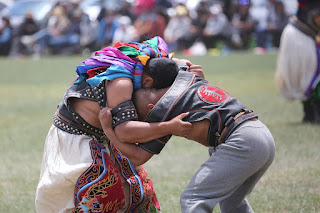Athletes excel in the ancient martial art of Mongolian wrestling through a combination of rigorous training, cultural dedication, and mastering key techniques unique to the sport. Mongolian wrestling, known as "Bökh" or "Bökh wrestling," holds deep cultural significance and requires athletes to develop physical prowess, mental fortitude, and a profound understanding of traditional techniques.
Training and Conditioning: Athletes undergo extensive physical training to build strength, endurance, and agility. This includes activities such as running, weightlifting, and practicing wrestling techniques. Exercises like "shagai" (traditional ankle bone throwing) contribute to lower body strength and balance, which are essential in Mongolian wrestling.
Technique Mastery: Mongolian wrestling emphasizes specific techniques that set it apart from other wrestling styles. Athletes learn to utilize leverage, grips, and throws that have been refined over generations. Techniques such as "zodog khurkhree" (waist grip with leg sweep) and "khishig khurkhree" (hooking ankle sweep) require precision and timing to execute effectively.
Mental Focus: Success in Mongolian wrestling demands mental resilience. Athletes must remain composed and focused, even in the face of intense physical contact. The ability to read opponents' movements and adapt strategies on the fly is crucial to outmaneuvering opponents.
Cultural Immersion: Mongolian wrestlers often immerse themselves in the cultural heritage of the sport. They participate in traditional ceremonies and rituals, paying homage to the sport's historical significance. This connection to their roots enhances their dedication and sense of pride in their performance....
Balanced Diet and Nutrition: Athletes maintain a balanced diet to fuel their demanding training regimen. Protein-rich foods like dairy products and meat are staples, contributing to muscle growth and recovery....
Experience and Mentorship: Mongolian wrestling is often passed down through generations, and experienced wrestlers play a significant role in mentoring younger athletes. Learning from seasoned practitioners helps novices refine their techniques and gain a deeper understanding of the sport.
Competitive Experience: Engaging in regular competitions, from local matches to national tournaments, allows athletes to put their skills to the test and gain valuable experience under varying conditions.
In essence, excelling in Mongolian wrestling requires a holistic approach that encompasses physical conditioning, technical proficiency, mental resilience, cultural immersion, and a deep respect for tradition. By embracing these elements, athletes can achieve mastery in this ancient martial art and honor its enduring legacy.
Photo: Pixabay (free)

No comments:
Post a Comment
Thanks for your comment.